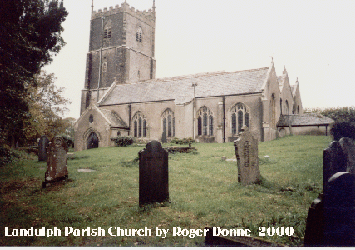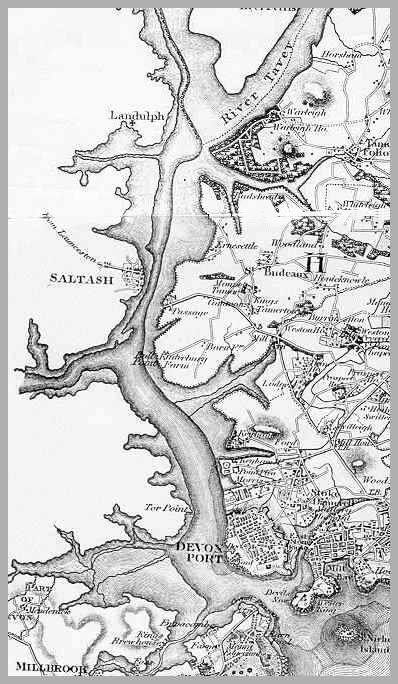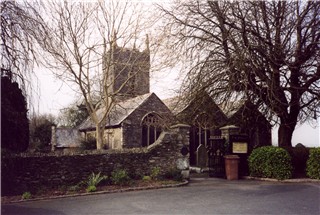Roger Donne’s Miscellany |
|
|
About This Site |
Cycling |
Family History |
Contact Me |
Site Map |
Links |
My Family History Pages
My interests
I have begun to record my family history and have started by writing down information I have found out about my mother's family - the Snell family of Landulph in the County of Cornwall. My original sources were primarily my mother's memory, a family bible, and various registration offices I have contacted to obtain birth, marriage and death certificates. Since I have published these pages, family members have supplied me with further information, and I have continued my researches through the catalogues of the National Archives at Kew, the Cornwall Record Office and the Plymouth and West Devon Record Office. I have provided a list of the references to Landulph Snells extracted from these catalogues, and annotated with my own comments on how they fit into the story.
Information obtained so far relates to the period from the early 1800 through to the present day. If you know of the family, or are related, or have any other information please contact me. Any information would be gratefully received and acknowledged, and in particular I am indebted to the late Norman Snell whose family research has far surpassed my own, and has been used to update these pages, to David Spear who pointed out some errors, and to Anne-Marie Snell who kindly supplied information on the South African connection.
Page Guide - Snell Pages
| Descendents of Benjamin Snell | Starting page giving access to Snell Family genealogy |
| Landulph Snells in the Archives | Summary of information in the Cornwall Record Office and Plymouth and West Devon Record Office relating to Landulph Snells |
| Benjamin Snell and John Kingdom | Summary of the litigation involving the supply of bread to French prisoners-of-war held at Plymouth |
Benjamin Snell at Wayton House
The early life of Benjamin Snell, said to be born about 1752 at Plymstock in the county of Devon, is difficult to trace. He appears to have been an inn keeper in ‘Dock’ a new town near Plymouth which grew up around the Royal Navy dockyards. Later, as a corn merchant, he prospered during the Napoleonic Wars of the 1790s and early 1800s. There is evidence of a marriage in 1780 in the parish of Stoke Damerel, which includes Plymoouth Dock, but all of his known descendents spring from a later marriage, when he was over the age of 50, and just after he had bought Wayton House in Landulph, from which he ran various businesses until his death in 1831.
While his early life obscure, he appears in records held at the National Archives as involved in litigation as one of the trustees representing the creditors of a certain John Kingdom, baker, of Truro. This is a fascinating story of the life and times of Benjamin Snell against the background of early 19th century history, which all started with the supply of bread to French prisoners of war held at the ‘depot’ at Plymouth Dock.
Local Geography - Landulph
Landulph is a large parish on the Cornish side of the River Tamar. It comprises several farms, and a large village, Cargreen, on the bank of the Tamar. Cargreen is mentioned by Richard Carew of Antony, in his Survey of Cornwall, published in 1602, in the following unflattering terms ".....Above Saltash, Cargreen, a fisher town, showeth itself, but can hardly muster a mean plight of dwellings; so may there care be green, because there wealth is withered......"
|
|
Landulph Parish Church is separated from the village at Cargreen, and stands isolated near Kingsmill Lake, an inlet from the Tamar and further downstream from Cargreen, towards the town of Saltash. In spite of its isolation, the church formed the centre of parish life, at least for members of the Church of England, in which baptisms, marriages and deaths were celebrated and recorded, and Sunday services were a religious duty and a social event. |
|
The river formed an important channel of communication in the 1800's and early 20th century linking the river villages and towns with the conurbation which, growing from three separate towns eventually and formed the City of Plymouth. Later, for foot passengers, the railway formed a link with Plymouth, although since the nearest railway line (the old Southern Railway) runs along the Devon bank, an expedition to Plymouth by rail involved, as my mother described, a passage across the Tamar from Cargreen to the Devon bank by a rowing boat ferry service, a walk across fields to the railway station at Bere Ferrers, and finally the train to Plymouth. The wonderful Great Western Railway ran up through Cornwall, crossing the Tamar at Saltash on Brunel's spectacular Royal Albert Bridge, but for the inhabitants of Landulph that involved a longer trip by road or downriver by boat. The map opposite shows the area in 1827, before the coming of the railways, but illustrates how important the river was to the communities along its banks. It also formed the focus and framework for my family history, |
|
A fascinating snapshot of local life in Cargreen is provided by a transcript of an article from the Cornish Times, published in 1897 which I found on a web-site prepared by the pupils of Liskeard School. The article is reproduced here, since it seems no longer available on-line and concerns the trial of one William Barrett following a minor affray on Cargreen Quay, after incidents on the river steamer 'Empress'. The article is of interest to me because it mentions a Snell as one of the character witnesses for the defendant; I suspect he is one of the Snells I am researching, probably William Benjamin Snell (1842-1932), the then-owner of Wayton House.
I have transcribed an auctioneer's catalogue from 1831 which I have in my possession, which describes various property in the districts of Landulph and St. Dominick, including the names of the occupiers. This also provides a view of the economy of the area, emphasising the importance of the River Tamar (e.g. Halton Quay) on the transportation of merchandise to serve the hinterland. Several other items relating to farms and property in Landulph, I've found in these transcripts of newspaper advertisments from 'Trewman's Exeter Flying Post' dating from the first half of the 19th century.
Page Guide - Landulph Pages
| Landulph Church | Transcription of a booklet written by Rev. Adams in the 1930's |
| Auctioneer's Catalogue 1831 | Transcription of an auctioneer's catalogue, showing properties in Landulph and the names of their owners in 1831 |
| Landulph Property in Newspaper Advertisments | Results of a search for Landulph references in the 'Exeter Flying Post' |
| An Affray at Cargreen | An Unwelcome Event at Cargreen reported in 'The Cornish Times' |
| Scenes from Village Life | This page presents some group photographs of Landulph parishioners dating from the early 20th century. Please contact me if you recognise any of the people shown. |
St Budeaux and Devonport
St Budeaux, on the Devon bank of the Tamar, is the setting for the other line in my family history. Once open farmland, it is now the site for a vast and sprawling suburb of Plymouth. My father's family lived here and it was here that I spent my early years.
|
|
Standing high above the Tamar, St Budeaux Parish Church has provided a focus for the old agricultural parish of St Budeaux, later added to by newer churches as the population of the parish expanded. It continues to provide an oasis of calm next to the busy A38 trunk road. |
Devonport, further south along the river from St Budeaux has also been significant in my family research. Devonport and the Naval Dockyard provided the opportunity for my ancestor, James Donne, to escape from his roots in the mines of Cornwall, and become an engineer in the Royal Navy. I have researched his career in the Navy and ships of the Victorian Navy in which he served. Devonport also provides the setting for my investigation of a year in the life of a young man-about-town in 1846, as told in the pages of his diary.
Page Guide - St. Budeaux, Devonport and the Victorian Navy
| On the Devon Bank of the Tamar | An overview of the history of the parish of St. Budeaux |
| From Tin Miner to Engineer RN | Summary of James Donne's career as Engineer RN, born the son of a miner in St Blazey, Cornwall |
| Life and Times of HMS Exmouth | An account of HMS Exmouth, a ship in which James Donne served from 1858 to 1862 - a typical ship of the Victorian Navy in transition from Nelson wooden walls to the the modern battleship |
| The Byers Diary | A description of a genealogical detective story, to find the name of the author of a pocket diary, and examining his life in Devonport in 1846 |
| Contents List of the Byers Diary | Transcript of the title pages of the Byers Diary |
| Transcript of Written Contents of Byers Diary | Transcript of the notes made by the owner in his diary, in 1846, during an eventful year of his life |
| Roger Donne's Ancestors | My ancestral tree, including details of my ancestors, their families and siblings |
Further West
As my researches have progressed, I have found the roots of my father's family line to lie further west, in Penwith in West Cornwall. The earliest family link I can trace is to the marriage of a Paskow Dun and Christian Ellis, in Camborne in 1581. From there, the family moved to St Erth about 1610 and numerous wills relating to this family exist in the archives, dating from the 17th century. Later, my particular branch moved to neighbouring Crowan, from ther to St. Blazey and out of Cornwall. Miscellaneous topics from my researches are linked below.
Page Guide - West Cornwall Links
| Donne family St Erth wills | Links to pdf files containing transcripts of Donne family wills from St Erth, dating from the 17th century |
| 1788 Estate Map of the Manor of Godolphin | Tenants and tenements in 1788 Godolphin Estate Map plotted onto Google Earth |
Reference Material
A number of other pages deal with the system of weights, measures and currency in use prior to decimalisation in the UK. This is useful in interpreting the areas of land, rents etc which are mentioned on the various other pages which I have transcribed.
I have also provided a price inflation calculator to answer the question of 'what's it worth now?'.
| Weights and Measures | A guide to the weights measures and currency used in the the 1831 auctioneers catalogue and in other pages on this site |
| Price Inflation Calculator | A calculator to indicate price inflation between any year after 1750 to 2001 |
This page last updated 25 October 2008


